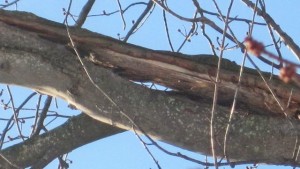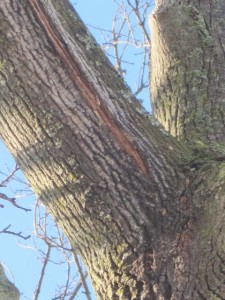Frost crack: What Is It?
Winter in the northern climes can be hard to survive. It’s cold and often dark, and many would prefer to hibernate or migrate than face our long winter months. Trees don’t have that option, so most go into a dormant state until spring arrives. And while people and animals revel in the sunny days that break up the dull winter expanse, that sunshine isn’t often as kind to our friends the trees.
 We all know that a sunny day increases the temperatures, at least marginally. When we get a sunny day in the dead of winter it warms up. But when night falls, temperatures plunge again. What does this mean for trees? Well, their bark warms in the sun’s rays, but quickly contracts again after it sets. The inner wood however takes longer to react. This can cause a split to occur, otherwise known as ‘frost cracks’.
We all know that a sunny day increases the temperatures, at least marginally. When we get a sunny day in the dead of winter it warms up. But when night falls, temperatures plunge again. What does this mean for trees? Well, their bark warms in the sun’s rays, but quickly contracts again after it sets. The inner wood however takes longer to react. This can cause a split to occur, otherwise known as ‘frost cracks’.

Frost crack in a maple tree
While cracks can be unsightly, they aren’t always dangerous to a tree’s health. When warmer weather returns, the cracks often close. That being said, the tree is then susceptible to the wound reopening again in successive winters. And while a tree might tree to heal the wound, it becomes a weak point where diseases and insects may attack.
The good news is that not all trees are affected by frost crack. Coniferous trees typically are immune to this winter ailment, as their needles protect their trunk and limbs from the temperature fluctuations due to the sun. Young trees with thinner bark however are not so lucky. Neither are sycamores, maples, oaks, walnuts and fruit trees, to name a few.
 Once a frost crack appears, there is little you can do about it. The tree may develop a frost rib at the site where the cracking occurs, but it won’t prevent future cracking. Keep an eye on the tree for sign of decay or insect infestation, fertilize as necessary, prevent soil compaction with aeration, and make sure your tree isn’t allowed to dry out in drought conditions.
Once a frost crack appears, there is little you can do about it. The tree may develop a frost rib at the site where the cracking occurs, but it won’t prevent future cracking. Keep an eye on the tree for sign of decay or insect infestation, fertilize as necessary, prevent soil compaction with aeration, and make sure your tree isn’t allowed to dry out in drought conditions.

There are a few things you can do to prevent frost crack from happening in the first place though. Planting evergreen shrubs around the base of the tree will help insulate it, plus shield it from direct sun. Applying white paint or white tree wrap to a tree’s trunk can also help to deflect the sun’s rays and reduce the risk of both frost crack and winter sunscald.
Sunscald is similar to frost crack, as it is also caused by fluctuating winter temperatures. In the case of winter sunscald though, the sun warms the tree promoting growth and when a rapid freeze follows, the inner wood freezes and dies, resulting in sunken wood, peeling bark and cracks along the tree. Like frost crack, it is usually seen on the southwest side of trees, as that is where the most direct sun is received later in the day.
If you are concerned about your trees, feel free to contact CLC Tree Services at (519) 685-0257. We would be more than happy to advise you on how to promote the health of your trees.




You must be logged in to post a comment.